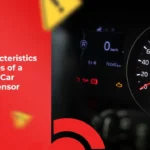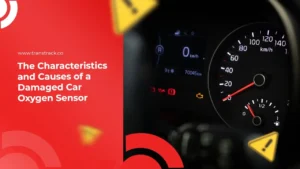Understanding Steering System Components, Types, Functions, and How They Work!
Posted on December 23, 2024 by Nur Wachda Mihmidati

The steering system of a car refers to the mechanism that allows the driver to control the vehicle’s direction. It is a crucial system in a car as it enables the driver to steer the vehicle according to their desired path. Let’s delve into the complete article with TransTRACK!
Components of the Steering System
This system comprises several components that work together. Some of the main components in this system include:
Steering Wheel
The steering wheel is the component that can be operated by the driver. The driver holds the steering wheel and moves it to change the direction of the vehicle.
Steering Rack
The steering rack is a mechanism that converts the rotational motion of the steering wheel into linear motion. It enables the movement of the front wheels to the right or left.
Steering Shaft
The steering shaft is a metal rod that connects the steering wheel to the steering rack. It transmits the rotational motion from the steering wheel to the steering rack.
Steering Linkage
The steering linkage is a component that connects the steering rack to the front wheels. It converts the movement of the steering rack into lateral movement of the right and left front wheels.
Driving Assistance System
Some modern cars are equipped with driving assistance systems, such as electric steering systems. This system utilizes an electric motor to assist the steering wheel’s movement, making it easier to maneuver the vehicle.
In addition to these components, the system also involves joints, connections, and other mechanisms that work together to ensure the driver can control the vehicle’s direction easily and accurately.
It is important to maintain this system in good condition to ensure the safety and proper control of the vehicle. Regularly inspecting and maintaining these system components, as well as performing repairs when necessary, are vital parts of routine vehicle maintenance conducted at an auto workshop.
Types of Car Steering Systems
Now, let’s delve into an in-depth explanation of the two commonly used types of steering systems:
Manual Steering System
The manual system is a traditional type that relies on the driver’s physical strength to move the steering wheel and change the vehicle’s direction. The main components of the manual system include the steering wheel, steering rack, steering shaft, and steering linkage.
In a manual system, the driver needs to exert more physical effort to turn the steering wheel, especially when making turns or parking the vehicle. The driver directly feels the pressure and resistance on the steering wheel, and they must provide enough force to overcome these obstacles.
The advantages of the manual system lie in its simplicity and reliability. It has fewer complex components, resulting in lower maintenance and repair costs compared to power steering systems. Additionally, some drivers believe that the manual system provides better feedback and a more direct driving experience.
Power Steering System
The power steering system, also known as the power-assisted system, employs mechanical or hydraulic assistance to reduce the effort required to turn the steering wheel. This system assists the driver by providing additional assistance when changing the vehicle’s direction.
The primary advantage of the power steering system is that it enables the driver to easily control the vehicle’s direction with less effort, especially during maneuvers like turning or parking. This makes the driver feel more comfortable and reduces the fatigue caused by the force required to turn the steering wheel.
The choice of the appropriate system depends on the driver’s preferences, vehicle requirements, and budget. The manual system is simpler and more affordable, while power steering provides greater comfort and assistance in controlling the vehicle. Technological advancements have also brought new innovations to these systems, such as more efficient electric steering and advanced automated systems.
The Function of the Car Steering System
The function of this system is crucial in controlling the vehicle’s direction and providing the driver with full control over its movement. Here is an in-depth explanation of the main functions of this system:
Changing the Vehicle’s Direction
The primary function of this system is to enable the driver to change the vehicle’s direction. By turning the steering wheel, the driver can adjust the positions of the left and right front wheels, thereby altering the vehicle’s direction. The system ensures accurate and immediate response to the driver’s commands, allowing the vehicle to maneuver precisely and safely.
Providing Driver Control
This system grants full control to the driver in steering the vehicle according to their intentions. Through the steering wheel, the driver can adjust the turning angle of the front wheels, enabling the vehicle to make turns, maneuvers, or lane changes with desired precision. The system needs to be responsive and provide accurate feedback to the driver, allowing them to sense and respond to road conditions effectively.
Maintaining Vehicle Stability
The system also plays a role in maintaining the vehicle’s stability during motion. By altering the angle of the front wheels, this system assists in preserving the vehicle’s balance while navigating corners, traversing uneven roads, or encountering uneven road surfaces. In emergency situations such as collision avoidance or aquaplaning, the system’s good steering control capability is crucial in preserving the vehicle’s stability.
Adjusting to Speed and Load
The system should also be able to adapt its response based on the vehicle’s speed and the load it carries. At low speeds, such as when parking, the system should provide greater assistance to facilitate the driver in maneuvering the steering wheel. On the other hand, at high speeds, the system’s response should be more controlled, requiring more effort from the driver to change the vehicle’s direction.
Integrating Advanced Technology
The steering system has also integrated advanced technology to enhance its performance. For example, power steering systems utilize hydraulic pumps or electric motors to provide power assistance to the driver. Electric systems enable more flexible control and integration with other safety features, such as automatic braking systems or stability control systems.
Overall, this system plays a vital role in giving the driver control over the vehicle’s direction. Through accurate response, good stability, and integration with modern technology, the system ensures that drivers can operate their vehicles safely, comfortably, and effectively. By changing the vehicle’s direction, providing driver control, maintaining stability, and adjusting responses to speed and load, the steering system plays a crucial role in a good driving experience.
How the Steering System Works
This system works by converting rotational motion on the steering wheel into linear motion on the front wheels, ultimately changing the vehicle’s direction. Here is an explanation of how the car steering system works in general:
Steering Wheel
The driver uses the steering wheel to provide input or commands regarding the desired direction. When the driver turns the steering wheel, this input is transmitted to other components within the system.
Steering Column
The input from the steering wheel is transmitted through the steering column, which is connected to the steering wheel. The steering column allows the movement of the steering wheel to the left and right.
Steering Rack
The steering rack function is to convert the rotational motion on the steering wheel into linear motion that is transmitted to the front wheels. Rack and pinion is a common design used in modern systems. In this design, the pinion connected to the steering wheel rotates and moves the rack linearly. This linear motion will actuate the tie-rod connected to the front wheels.
Tie-Rod Bar
The tie-rod connects the steering rack to the suspension mechanism on the front wheels. When the steering rack moves linearly, the tie-rod will change the angle of the left and right front wheels. This change in angle will alter the vehicle’s direction.
Power Steering Components (Optional)
If the vehicle is equipped with a power steering system, there are additional components involved in how this system works. In hydraulic power steering systems, the power steering pump generates hydraulic pressure that is sent to the power steering mechanism to provide power assistance. In electric power steering systems, an electric motor provides power assistance as needed.
Feedback and Control
This system is also equipped with feedback that provides the driver with information about the steering condition and the vehicle’s response to the driver’s commands. This feedback can be in the form of a sensation on the steering wheel, the driver’s response to steering wheel rotations, or visual indicators on the dashboard. Additionally, the system may have controls that monitor road conditions, vehicle speed, and other factors to adjust the steering system’s response.
The way this system works can vary depending on the type of system used, whether it’s a manual system, hydraulic power steering, or electric power steering. However, the basic principle that allows the driver to change the vehicle’s direction remains the same, which is converting rotational motion on the steering wheel into linear motion on the front wheels.
Vehicle Steering System Maintenance
The steering system is one of the vital components of a vehicle that functions to steer the wheels according to the driver’s wishes. To keep the steering system working optimally and safely, regular maintenance is important. The following is a discussion of the steps for steering system maintenance:
1. Routine Inspection of Steering System Components
- Tie Rod and Ball Joint: Tie rod and ball joint are the link between the steering mechanism and the wheel. Check these components regularly to ensure there is no damage or wear that could reduce steering stability.
- Steering Rack and Gearbox: Ensure that the steering rack or gearbox has no leaks or mechanical damage that could affect steering system response.
- Steering Column: Check the straightness and smoothness of the steering column to ensure the steering wheel can turn without resistance.
2. Power Steering Fluid Replacement (If Using Hydraulic)
- Fluid Condition: Power steering fluid must be clean and uncontaminated. Dirty fluid can reduce power steering performance and damage components in the system.
- Replace the power steering fluid as recommended by the vehicle manufacturer, usually every 40,000-80,000 km or sooner if there are signs of damage, such as noise when turning the steering wheel.
- Check for leaks in the fluid reservoir and hydraulic lines, as leaks can cause pressure loss that affects the power steering function.
3. Electric Steering System (EPS – Electric Power Steering) Calibration
- Electric Sensor Monitoring: The electric steering system is equipped with sensors that need to be calibrated periodically to maintain accuracy. Interference with the sensors may affect steering sensitivity.
- Electric Motor Check: Make sure that the electric motor on the EPS is working properly and that there are no electrical problems such as broken wires or loose connectors.
4. Tire Maintenance and Wheel Balancing
- Tire Alignment: Poor tire alignment can cause the steering system to become heavy and the vehicle difficult to control. Perform regular wheel checks and alignment.
- Wheel Balancing: Unbalanced tires can cause vibration in the steering wheel, affecting steering comfort and performance. Ensure wheel balancing is done regularly, especially after replacing tires.
- Tire Pressure: Keep the tire pressure within the manufacturer’s recommendations. Over-inflated or over-inflated tires can increase the load on the steering system.
5. Cleaning and Lubrication of Mechanical Components
- Ball Joint and Tie Rod Lubrication: Components such as ball joints and tie rods require lubrication to prevent rapid wear. Use the appropriate grease to ensure the components move smoothly.
- Routine Cleaning: Clean steering system components of dirt or sludge that may inhibit movement or cause corrosion.
6. Suspension System Check
- A faulty suspension system can affect vehicle stability and steering system response. Therefore, make sure the shock absorber and suspension bushings are in good condition.
- Steering and Suspension Connections: Make sure there are no loose components between the steering and suspension systems.
7. Detect and Repair Problems Early
- If a squeaking or noisy sound is heard when turning the steering wheel, check the system immediately to detect problems such as fluid leaks or worn components.
- Vibration in the Steering Wheel: Vibration in the steering wheel can be a sign of a wheel balancing problem or a loose tie rod. Have it checked immediately to avoid further damage.
- Difficulty Driving: If the steering wheel feels heavy or difficult to move, check the power steering, both hydraulic and electric.
8. Performing Periodic Servicing at an Authorized Workshop
- Technician Expertise: Maintenance should be performed by an experienced technician, especially if it involves electric power steering (EPS) or steer-by-wire systems that require specialized tools.
- Carry out periodic servicing to check all steering system components and make any necessary replacements.
Maintaining the steering system is an important part of overall vehicle maintenance. By performing regular checks, changing the appropriate oil or fluid, and maintaining the condition of the tires and suspension, you can ensure that the steering system remains optimally functional and safe to use. Good maintenance can also prevent you from incurring expensive repair costs due to damage to steering system components.
To ensure optimal performance of this system, proper maintenance is essential. One way to ensure the reliability of the steering system and its components is by using the Vehicle Maintenance System from TransTRACK.
By using the Vehicle Maintenance System from TransTRACK, users can improve the efficiency of vehicle maintenance, including the steering system. With regular and timely maintenance, users can ensure that the car steering system works properly, enhancing safety, and extending the lifespan of steering system components.
Do not hesitate to make TransTRACK your reliable and effective vehicle maintenance solution to maximize the performance of your car steering system.
Topic :
 Bahasa Indonesia
Bahasa Indonesia









